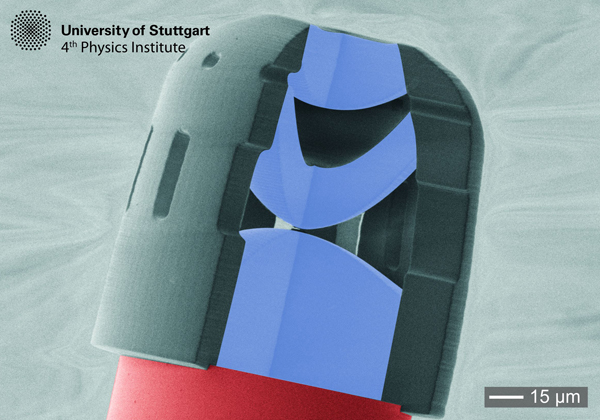3D Printing Brings Focus to Micro-cameras

Complex triplet lens by femtosecond 3D printing on a single mode optical fiber. Courtesy of UofS.
Latest News
July 1, 2016
There’s been plenty of copy written about additive manufacturing’s (AM) growing pains in scaling up production. Some people want the process to go faster, some want it to be bigger. While a mass produced, 3D printed car body would be neat, it may well be the other end of the size scale that is most important.
Researchers at the University of Stuttgart (UofS) have been focusing on the micro, rather than the macro, in their work with imaging systems. The result is a 3D printing process for building lenses that allows for the creation of micro-cameras. The cameras are measured in microns, and have the potential to positively impact a number of fields, including medical.
 Complex triplet lens by femtosecond 3D printing on a single mode optical fiber. Courtesy of UofS.
Complex triplet lens by femtosecond 3D printing on a single mode optical fiber. Courtesy of UofS.To build a micro-camera you need to start with some kind of backing. At UofS they worked with both glass and optical fibers. Using either as a base, the team then directed a precision laser AM system with pulses measured in femtoseconds (one quadrillionth of a second) into a liquid photoresist, which crosshairs and hardens the polymer. Once a build is complete, extraneous photoresist is washed away, leaving a tiny lens behind.
The process allows for free form lens creation in a variety of shapes, including the standard spherical lens, as well as paraboloids or aspheres. The process can also produce micro-cameras with two or more lenses, which, according to UofS, is a first. Completed lenses have a diameter and height of 125 µm.
Used in the medical field, micro-cameras can be inserted via hypodermic needle virtually anywhere in a body to give doctors a first-hand look around. The cameras could also be useful in peering inside mechanical objects — either acting as quality assurance, or to identify damaged parts in the interior of complex machines.
Another potential application is the creation of tiny security cameras. It would be possible to build cameras into nearly anything, including small drones, creating swarms of autonomous security patrols.
The process used to create the cameras is flexible and speedy by AM standards, and has the potential to launch a new kind of optical manufacturing.
“The time from the idea, the optics design, a CAD model, to the finished, 3D printed micro-objectives is going to be less than a day,” said Harald Giessen, professor of physics at UofS. “We are going to open potentials just like computer-aided design and computer-integrated manufacturing did in mechanical engineering a few years ago.”
Below you’ll find a video about laparoscopic surgery. Consider how even that minimally invasive procedure could be improved by micro-cameras.
Source: UofS
Subscribe to our FREE magazine, FREE email newsletters or both!
Latest News
About the Author
John NewmanJohn Newman is a Digital Engineering contributor who focuses on 3D printing. Contact him via [email protected] and read his posts on Rapid Ready Technology.
Follow DE





